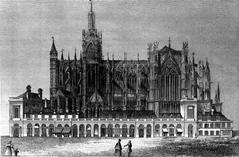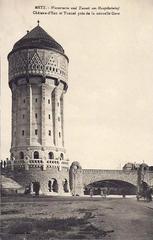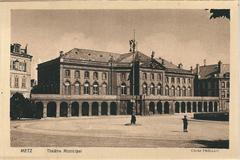
Abbey of Saint-Arnould: Visiting Hours, Tickets, and Complete Guide to Metz’s Historical Gem
Date: 04/07/2025
Introduction: The Abbey of Saint-Arnould and Its Significance
The Abbey of Saint-Arnould in Metz, France, is a remarkable monument that encapsulates centuries of religious devotion, royal heritage, and architectural evolution. Founded with roots tracing as far back as the early Christian era and officially recorded from the 6th century, this abbey has continually shaped—and been shaped by—the shifting tides of Metz’s spiritual, cultural, and political life. As the custodian of the relics of Saint Arnulf of Metz, a pivotal figure in the Merovingian and Carolingian dynasties, and the burial site of several Carolingian royals, the abbey stands as a testament to Metz’s enduring historical prominence.
Over the centuries, the abbey has survived invasions, fires, and military conflicts, each time adapting and rebuilding. Today, the Abbey of Saint-Arnould is both a cultural landmark and a living narrative of Metz’s layered past. Its architectural highlights—including the 17th-century cloister and the rediscovered early 16th-century pietà—invite visitors to step into an immersive experience of history and art. Conveniently located near other major attractions such as Metz Cathedral and Centre Pompidou-Metz, the abbey is a must-visit for history buffs, art lovers, and travelers alike.
For further reading, consult Wikipedia, Spotting History, and wikimetz.fr.
Table of Contents
- Introduction
- Historical Overview
- Visitor Information
- Architectural and Artistic Highlights
- Frequently Asked Questions (FAQ)
- Summary and Further Resources
- Contact Information
Historical Overview
Origins and Early History
Tradition traces the abbey’s foundation to Bishop Patient of Metz in the 2nd century CE as the Basilica of St. John the Evangelist, with verifiable records emerging in the 6th century (Wikipedia). Its strategic location near major Roman roads fostered its early development as a civic and religious hub (Spotting History).
Relics and Royal Connections
In 641, the relics of Saint Arnulf of Metz were transferred to the abbey, elevating its religious significance and drawing pilgrims from across the region. Renamed in his honor in 717, the abbey became the burial site for important Carolingian royals, including Charlemagne’s wife Hildegarde and son, Emperor Louis the Pious (Spotting History; wikimetz.fr).
Medieval Upheaval and Restoration
The abbey faced repeated destruction, notably by Norman invaders in the 9th century and by fire in 1097, but was continually rebuilt. In 1552, during the siege of Metz, it was destroyed for strategic military reasons, prompting the transfer of relics and the monastic community to a Dominican convent (wikimetz.fr).
Architectural Evolution
Reconstruction in the 17th century under Bishop Guillaume-Egon de Fürstenberg introduced the cloister, refectory, and sacristy. In 1990, a hidden pietà from c.1520 was unearthed, preserved from Revolutionary destruction (wikimetz.fr; Spotting History).
French Revolution and Modern Era
The French Revolution led to the abbey’s secularization and repurposing as a military institution, later becoming the Cercle des Officiers. Despite the loss of many original tombs and relics, remnants survive in local museums (Wikipedia).
Visitor Information
Location and Access
- Address: 7 Rue aux Ours, 57000 Metz, France
- Coordinates: 49°7’5.045” N, 6°10’18.04” E (Tripomatic)
- Getting There:
- On foot: 10-minute walk from Metz Cathedral or Centre Pompidou-Metz.
- Public transport: Bus and tram lines stop nearby; the ‘Amphithéâtre’ tram stop is closest.
- By car: Public parking available within walking distance.
Opening Hours (As of July 2025)
- Monday to Saturday: 10:00 AM – 6:00 PM
- Sunday and Public Holidays: 12:00 PM – 5:00 PM
- Note: Special open days and cultural events may alter these hours. Always confirm on the official website.
Tickets and Accessibility
- Entry: Free for individual visitors. Guided tours and special events may require tickets (€3–€5).
- Accessibility: Main areas are wheelchair accessible; ramps and accessible restrooms are available, though some historic sections may have limited access. Contact ahead for assistance.
- Amenities: Restrooms, gift shop, brochures, and audio guides are available.
Guided Tours and Events
- Guided Tours: Offered in French, with English and German available upon request. Tours last ~45–60 minutes and can be booked via the official website.
- Special Events: The abbey hosts exhibitions, concerts, and lectures, especially around the feast day of Saint Arnould (July 18).
- Self-Guided Visits: Brochures and audio guides available for independent exploration.
Visitor Tips
- Dress Code: Modest attire required; shoulders and knees covered. Hats off inside.
- Photography: Permitted in most areas without flash or tripods; prohibited during services.
- Best Time to Visit: Weekday mornings or outside major holidays for a quieter experience.
- Travel Safety: Metz is generally safe; standard precautions apply. Emergency numbers: 112 (general), 17 (police).
Nearby Attractions
- Metz Cathedral (Cathédrale Saint-Étienne): 10-minute walk, famed for its Gothic architecture.
- Centre Pompidou-Metz: Modern art museum, 1.5 km away.
- Place Saint-Louis: Lively square with cafés and shops.
- Other: Église Saint-Pierre-aux-Nonnains, Imperial Quarter.
Architectural and Artistic Highlights
- Cloister, Refectory, and Sacristy: Exemplary 17th-century architecture.
- Pietà (c.1520): Rediscovered sculpture, a rare survivor from the abbey’s medieval art.
- Tombs and Relics: Surviving fragments of Carolingian burials and religious artifacts.
- Building Materials: Jaumont limestone, distinctive to Metz’s historic structures.
Frequently Asked Questions (FAQ)
Q: Are there entrance fees to the Abbey of Saint-Arnould?
A: Entry is free for individuals; guided tours or events may require a €3–€5 ticket.
Q: What are the regular visiting hours?
A: Monday–Saturday 10:00 AM–6:00 PM; Sunday/public holidays 12:00 PM–5:00 PM. Confirm before visiting.
Q: Is the abbey accessible for people with disabilities?
A: Main areas are accessible; some sections may have steps or uneven floors.
Q: Are guided tours available in English?
A: Yes, upon request. Advance booking is recommended.
Q: Can I take photos inside?
A: Yes, except during services. No flash or tripods.
Q: How do I get there by public transport?
A: Nearest tram stop is ‘Amphithéâtre’; several bus routes serve the area.
Summary and Invitation to Explore More
The Abbey of Saint-Arnould exemplifies Metz’s rich historical tapestry—combining medieval devotion, royal heritage, and striking architecture. Whether you’re drawn by its relics, its stories of resilience, or its artistic treasures, the abbey promises a memorable journey through the centuries. Make the most of your visit by checking current hours, booking a guided tour, and exploring nearby landmarks for a complete Metz experience.
For the latest updates, download the Audiala app for audio tours, and follow us on social media for events and travel tips.
Contact Information
- Address: 7 Rue aux Ours, 57000 Metz, France
- Phone: +33 (0)3 87 00 00 00 (verify via official website)
- Website: abbey-of-saint-arnould.slue.io
Further Reading and Reliable Sources
- Abbey of Saint-Arnould, Wikipedia
- Spotting History: Abbey of Saint-Arnould
- wikimetz.fr: Abbaye Saint Arnould
- Tout-Metz: Abbaye Saint-Arnoul
- Metz Tourisme
- Tripomatic: Abbey of Saint-Arnould
Plan your visit, enrich your experience, and step into the enduring legacy of the Abbey of Saint-Arnould.










